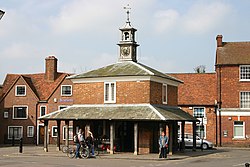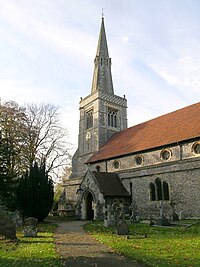Princes Risborough
| Princes Risborough | |
| Buckinghamshire | |
|---|---|
 Princes Risborough Market House | |
| Location | |
| Grid reference: | SP798030 |
| Location: | 51°43’26"N, -0°50’4"W |
| Data | |
| Population: | 7,978 (2001) |
| Post town: | Princes Risborough |
| Postcode: | HP27 |
| Dialling code: | 01844 |
| Local Government | |
| Council: | Buckinghamshire |
| Parliamentary constituency: |
Buckingham |
Princes Risborough is a small town in Buckinghamshire which sits sheltered beneath the scarp slope of the Chilterns, where the land flattens out into the Vale of Aylesbury, a place where the landscape changes dramatically from the rough, wooded hills to the gentle farmland beyond. It shapes the town and brings roads and the railway through the land here which could not so easly scale the hills above.
Princes Risborough is one of a pair with neighbouring Monks Risborough.
The town sits 9 miles south of the county town, Aylesbury and 8 miles northwest of High Wycombe. Bledlow lies to the west and Monks Risborough to the east. It lies at the north end of a pass through the Chilterns, the south end of which is at West Wycombe: the A4010 road follows this route from West Wycombe through the town and then on to Aylesbury.
It gives its name to the Risborough Hundred, which also encompasses Bledlow, Horsenden and Monks Risborough.
Historically this town was both a manor and an ecclesiastical parish of the same extent. The parish included the present parish of Princes Risborough (excluding Ilmer) and also today's parish of Lacey Green, which became a separate parish in the 19th century. It was long and narrow "strip parish", taking in land below the Chiltern scarp, the slope of the scarp itself and also land above the scarp extending into the Chiltern Hills. The manor and the parish extended from Longwick in the north through Alscot, the town of Princes Risborough, Loosley Row and Lacey Green to Speen and Walters Ash in the south.
A civil parish has been created which since 1934 has included Princes Risborough, Monks Risborough and part of Horsenden but has excluded Longwick.
The town is overlooked by the Whiteleaf Cross, carved in the chalk of the hillside, though the cross itself is in Monks Risborough.
The name
The name 'Risborough' means "'brushwood-covered hill", from the Old English hrisen beorg. The spelling in the various documents where the name is found is, as usual, very variable.[1]
In the 13th century the parish is found as Magna Risberge (Great Risborough), distinguished from Parva (Little) Risberge, which was Monks Risborough. Later it appears as Earls Risborough. When the manor came to be held by Edward Prince of Wales ("the Black Prince", son of King Edward III) it came to be called as Princes Risborough, which name has remained.[1]
Churches

Parish church
The parish church is St Mary's. In its present general form it dates from the 13th century, with later enlargements. It may stand on the site of an earlier church. By the 19th century the church's poor condition led to an extensive restoration and partly rebuilding in 1867/68. The tower and spire was rebuilt in 1907/08 and parish rooms added in the 21st century.
The church originally had a tower with a spire above it, probably built in the 15th century, but this spire fell down in 1803, damaging the church and destroying a peal of bells. A new stone spire was built, octagonal in shape, and described in 1862 as covered with galvanised iron.[2] In 1907/08 a new tower and spire were built from the foundations.
-
The interior of the church looking east
-
Three lancet window in the south aisle
-
Piscina & sedile in south aisle
-
North Aisle
-
The church from the north west, showing parish rooms
-
The church seen from the east
In 1765 the Earl of Buckingham gave the rectory of Princes Risborough to the manor at Nutley Abbey in Long Crendon, to which it is still attached today.
Others
- Church of England: St Mary's (above)
- Baptist: Risborough Baptist Church, off Bell Street, built in 1804-05 and later extended, but taking on the long tradition of non-conformis congregations in Buckinghamshire: the first Baptist meetings here are the Particular Baptists recorded in 1701, and land for the first chapel was acquired in 1707.
- Methodist: Princes Risborough Methodist Church
- Pentecostal (Elim): Chilterns Christian Fellowship
- Roman Catholic: St Teresa's: an interesting domed church (by an Italian architect) prominently placed on the corner of the Aylesbury Road and New Road, built in 1937-38.
History
Risborough in 1086
At the time of the Domesday survey in 1086, Princes Risborough was a royal manor held by the King, having been a village of King Harold before the conquest.
It was assessed at 30 hides both before and after the conquest, of which 20 hides related to the demesne. The manor had land for 24 ploughs, four of them in the lord's demesne. There were 30 villagers and they together with 12 bordars (cottagers or small holders[3]) had 20 ploughs. There were 3 slaves. There were 2 mills, worth 14s 8d a year, meadow for 7 ploughteams (generally taken as needing 8 oxen each) and woodland sufficient for 1,000 pigs. In total it paid £47 a year in white silver, less 16d. Before 1066 it only paid £10 at face value (i.e. without weighing the coins). Furthermore a burgess of Oxford paid 2s and a saltboiler of Droitwich an amount left blank. A freeman held 3 virgates and had the right to sell his land, though it was said that he served the sheriff.[4]
On the above figures it is estimated that the total population of the manor in 1086 would have been about 200.
Middle Ages
In the 12th century thre manor was held by Walter Giffard, the 2nd Earl of Buckingham, but reverted to the Crown on his death in 1164. It was then granted to the Constable of Normandy, Robert de Humeto, who obtained a charter from King Henry II, and remained in his family until about 1242. King Henry III then granted the Manor to Richard, Earl of Cornwall (2nd son of King John), succeeded by his son, Edward, who died in 1300, when it fell back to the Crown.
King Edward I in 1302/05 granted it to Queen Margaret for her life, subject to the rights of Margaret, Countess of Cornwall, in one third part for life as part of her dower. King Edward II gave the reversion (subject to these life interests) to his unpopular favourite, Piers Gaveston, and his wife, but this grant was surrendered in the same year. Queen Margaret died in 1316. In 1327, when Edward III succeeded to the throne at the age of fifteen, he granted the Manor for life to his mother, Queen Isabella for her services during his father's reign. The King's brother, John, Earl of Cornwall, also had an interest for a time. After the death of the Queen-mother it was held by Henry de Ferrers until his death in 1344.
Edward III granted the Manor of Risborough to his eldest son, Edward Prince of Wales, known to history and Shakespeare as the Black Prince. He was 14 years of age in 1344 and he held the Manor for 32 years until his death in 1376, a year before his father the King. It was during his tenure that the Manor became known as Princes Risborough. Several later Kings in turn granted the manor to their heirs: Henry IV to the Prince of Wales, later Henry V; Henry VI gave it as part of a dowry to his Queen, Margaret of Anjou; then to their son, Edward; Edward VI gave it to his half-sister, who ascended as Elizabeth I. James I endowed his Queen, then the Prince Charles, later Charles I
In 1628 King Charles I sold the manor to the City of London in part satisfaction of the large debts of the Crown, after which it passed through many hands.
Market and fairs
In 1523 King Henry VIII granted Princes Risborough the right to hold a weekly market and two yearly fairs, the market to be held on Wednesdays and the fairs on the eve, day and morrow of the Feast of the Nativity of the Blessed Virgin (8 September) and on the eve, day and morrow of St George's Day (23 April). The days were changed from time to time, the market to Saturday before 1792 and to Thursday in 1888. In 1792 there was only one fair (6 May) but the second was revived and by 1908 was held on 21 October.[5]
The town today
Princes Risborough is on the fast railway line between Birmingham and Aylesbury to London and is popular with commuters.
Since the reintroduction of the Red Kite to the Chiltern Hills, Princes Risborough has become an ideal place to view this bird of prey. They are often sighted above the town and surrounding areas.
Princes Risborough on television
Princes Risborough has been featured several times in films and television series (e.g. Jonathan Creek, Inspector Morse, Midsomer Murders and Double First).
Big Society
Sports and recreation
- Bowls: Princes Risborough Bowls Club
- Cricket: Princes Risborough Cricket Club
- Football: Risborough Rangers FC
- Golf:
- Princes Risborough Golf Club at Saunderton Lee (9 holes).
- Whiteleaf Golf Club at Monks Risborough (9 holes)
- Motorsport: The Kop Hill Climb is one of the oldest Hill Climb venues in Britain, established in 1910.
- Rugby: Risborough Rugby Football Club
- Tennis: Princes Risborough Lawn Tennis Club
Princes Risborough has a recreation ground on the left of the Aylesbury Road, known as King George's Field as a memorial to King George V.
Outside links
| ("Wikimedia Commons" has material about Princes Risborough) |
References
- ↑ 1.0 1.1 See Mawer & Stenton: Place Names of Buckinghamshire pp.170-1
- ↑ James Joseph Shearman: History & Topography of Bucks (London. 1862) pp.192-3
- ↑ Bordar is the English translation of the latin word bordarius, which is the standard word used in Domesday Book for a villein of the lowest class, holding a cottage and some land at the will of the lord of the manor in return for work or services which he was obliged to render on the manor
- ↑ Domesday Book Buckinghamshire 1,3
- ↑ VHCB p.260. The original grant was made on 15 July 1523 and is in Letters and Papers Foreign & Domestic Henry VIII, Vol.III, part II. Ed: J S Brewer (London 1867) p.1337
Books
- Barber, Richard: Edward Prince of Wales and Aquitaine 'A biography of the Black Prince' (London 1978)
- Domesday Book (text & translation edited by John Morris) Vol 13 Buckinghamshire (Phillimore, Chichester 1978)
- Lipscomb, George: The History and Antiquities of the County of Buckingham (London. 1847)
- Mawer, A. and Stenton, F.M: The Place Names of Buckinghamshire (Cambridge, 1925)
- Register of Edward the Black Prince, preserved in the Public Record Office '4 volumes' (H.M.S.O. 1930-33)
- VHCB=Victoria History of the County of Buckingham, ed: William Page, Volume 2 (1908), pages 260-267
- Pevsner, Nikolaus & Elizabeth Williamson: Buckinghamshire (The Buildings of England - Penguin Books. 2nd edition. 1994)
- RCHMB=Royal Commission on Historical Monuments (England): An Inventory of the Historical Monuments in Buckinghamshire, Volume 1 (1912)






